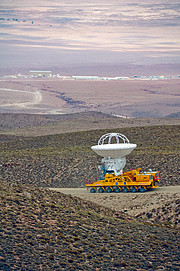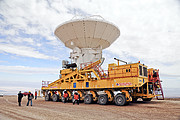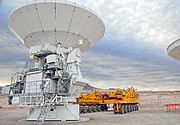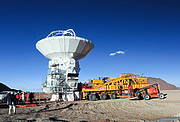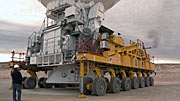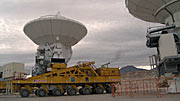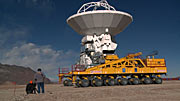Komunikat prasowy
ALMA telescope reaches new heights
23 września 2009
The ALMA (Atacama Large Millimeter/submillimeter Array) astronomical observatory has taken another step forward — and upwards. One of its state-of-the-art antennas was carried for the first time to the 5000m plateau of Chajnantor, in the Chilean Andes, on the back of a custom-built giant transporter. The antenna, which weighs about 100 tons and has a diameter of 12 metres, was transported up to the high-altitude Array Operations Site, where the extremely dry and rarefied air is ideal for ALMA’s observations of the Universe.
The conditions at the Array Operations Site on Chajnantor, while excellent for astronomy, are also very harsh. Only half as much oxygen is available as at sea level, making it very difficult to work there. This is why ALMA’s antennas are assembled and tested at the lower 2900 m altitude of the ALMA Operations Support Facility. It was from this relatively hospitable base camp that the ALMA antenna began its journey to the high Chajnantor site.
“This is an important moment for ALMA. We are very happy that the first transport of an antenna to the high site went flawlessly. This achievement was only possible through contributions from all international ALMA partners: this particular antenna is provided by Japan, the heavy-lift transporter by Europe, and the receiving electronics inside the antenna by North America, Europe, and Asia”, said Wolfgang Wild, European ALMA Project Manager.
The trip began when one of the two ALMA transporters, named Otto, lifted the antenna onto its back. It then carried its heavy load along the 28 km road from the Operations Support Facility up to the Array Operations Site. While the transporter is capable of speeds of up to 12 km/hour when carrying an antenna, this first journey was made more slowly to ensure that everything worked as expected, taking about seven hours.
The ALMA antennas are the most advanced submillimetre-wavelength antennas ever made. They are designed to operate fully exposed in the harsh conditions of the Array Operations Site. This means surviving strong winds and temperatures between +20 and -20 Celsius whilst being able to point precisely enough that they could pick out a golf ball at a distance of 15 km, and to keep their smooth reflecting surfaces accurate to better than 25 micrometres (less than the typical thickness of a human hair).
Once the transporter reached the high plateau it carried the antenna to a concrete pad — a docking station with connections for power and fibre optics — and positioned it with an accuracy of a few millimetres. The transporter is guided by a laser steering system and, just like some cars today, also has ultrasonic collision detectors. These sensors ensure the safety of the state-of-the-art antennas as the transporter drives them across what will soon be a rather crowded plateau. Ultimately, ALMA will have at least 66 antennas distributed over about 200 pads, spread over distances of up to 18.5 km and operating as a single, giant telescope. Even when ALMA is fully operational, the transporters will be used to move the antennas between pads to reconfigure the telescope for different kinds of observations.
“Transporting our first antenna to the Chajnantor plateau is a epic feat which exemplifies the exciting times in which ALMA is living. Day after day, our global collaboration brings us closer to the birth of the most ambitious ground-based astronomical observatory in the world”, said Thijs de Graauw, ALMA Director.
This first ALMA antenna at the high site will soon be joined by others and the ALMA team looks forward to making their first observations from the Chajnantor plateau. They plan to link three antennas by early 2010, and to make the first scientific observations with ALMA in the second half of 2011.
ALMA will help astronomers answer important questions about our cosmic origins. The telescope will observe the Universe using light with millimetre and submillimetre wavelengths, between infrared light and radio waves in the electromagnetic spectrum. Light at these wavelengths comes from some of the coldest, but also from some of the most distant objects in the cosmos. These include cold clouds of gas and dust where new stars are being born and remote galaxies towards the edge of the observable universe. The Universe is relatively unexplored at submillimetre wavelengths, as the telescopes need extremely dry atmospheric conditions, such as those at Chajnantor, and advanced detector technology.
Więcej informacji
The Atacama Large Millimeter/submillimeter Array (ALMA), an international astronomy facility, is a partnership of Europe, North America and East Asia in cooperation with the Republic of Chile. ESO is the European partner in ALMA. ALMA, the largest astronomical project in existence, is a revolutionary telescope, comprising an array of 66 giant 12-metre and 7-metre diameter antennas observing at millimetre and submillimetre wavelengths. ALMA will start scientific observations in 2011.
ESO, the European Southern Observatory, is the foremost intergovernmental astronomy organisation in Europe and the world’s most productive astronomical observatory. It is supported by 14 countries: Austria, Belgium, Czechia, Denmark, France, Finland, Germany, Italy, the Netherlands, Portugal, Spain, Sweden, Switzerland and the United Kingdom. ESO carries out an ambitious programme focused on the design, construction and operation of powerful ground-based observing facilities enabling astronomers to make important scientific discoveries. ESO also plays a leading role in promoting and organising cooperation in astronomical research. ESO operates three unique world-class observing sites in Chile: La Silla, Paranal and Chajnantor. At Paranal, ESO operates the Very Large Telescope, the world’s most advanced visible-light astronomical observatory. ESO is the European partner of a revolutionary astronomical telescope ALMA, the largest astronomical project in existence. ESO is currently planning a 42-metre European Extremely Large optical/near-infrared Telescope, the E-ELT, which will become “the world’s biggest eye on the sky”.
Linki
Kontakt
Wolfgang Wild
ESO
Garching, Germany
Tel.: +49 89 3200 6716
E-mail: wwild@eso.org
Douglas Pierce-Price
ESO
Garching, Germany
Tel.: +49 89 3200 6759
E-mail: dpiercep@eso.org
O komunikacie
| Komunikat nr: | eso0935 |
| Legacy ID: | PR 35/09 |
| Nazwa: | Atacama Large Millimeter/submillimeter Array |
| Typ: | Unspecified : Technology : Observatory : Telescope |
| Facility: | Atacama Large Millimeter/submillimeter Array |



